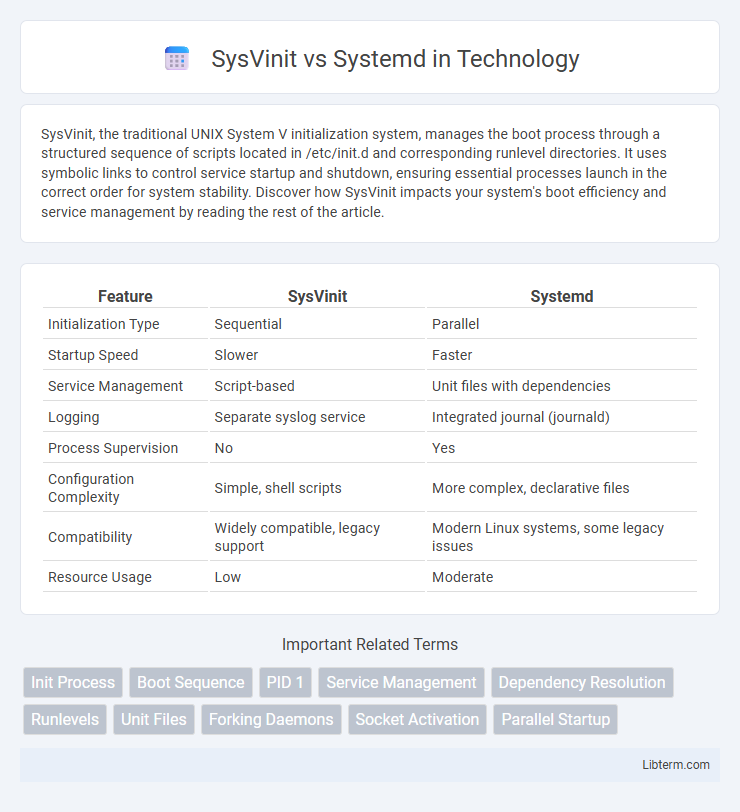SysVinit, the traditional UNIX System V initialization system, manages the boot process through a structured sequence of scripts located in /etc/init.d and corresponding runlevel directories. It uses symbolic links to control service startup and shutdown, ensuring essential processes launch in the correct order for system stability. Discover how SysVinit impacts your system's boot efficiency and service management by reading the rest of the article.
Table of Comparison
| Feature | SysVinit | Systemd |
|---|---|---|
| Initialization Type | Sequential | Parallel |
| Startup Speed | Slower | Faster |
| Service Management | Script-based | Unit files with dependencies |
| Logging | Separate syslog service | Integrated journal (journald) |
| Process Supervision | No | Yes |
| Configuration Complexity | Simple, shell scripts | More complex, declarative files |
| Compatibility | Widely compatible, legacy support | Modern Linux systems, some legacy issues |
| Resource Usage | Low | Moderate |
Introduction to Init Systems
SysVinit and Systemd are two primary init systems used to bootstrap user space and manage system processes during startup. SysVinit relies on traditional shell scripts organized in runlevels to start and stop services sequentially, resulting in slower boot times. Systemd introduces parallelization, socket activation, and a dependency-based service model, significantly improving boot speed and overall system management efficiency.
What is SysVinit?
SysVinit is a traditional initialization system used in Unix-like operating systems to bootstrap the user space and manage system services during startup and shutdown. It relies on a series of shell scripts organized in runlevels, which define the state and services of the system. SysVinit operates sequentially, leading to slower boot times compared to parallel execution models like systemd.
What is Systemd?
Systemd is a modern system and service manager for Linux operating systems designed to replace the traditional SysVinit system. It improves boot speed, manages system processes, and supports advanced features like parallel startup, on-demand daemon activation, and system state snapshots. Systemd integrates tightly with the Linux kernel, offering better dependency tracking and unified management of system services and resources.
Core Differences Between SysVinit and Systemd
SysVinit uses a sequential, script-based approach to start and stop services during system boot, relying on predefined runlevels and shell scripts located in /etc/init.d, which can lead to slower boot times and less flexible service management. Systemd employs parallelized startup of services through unit files, event-based activation, and dependency tracking, significantly improving boot speed and resource management. Key differences include systemd's use of binary logs (journald), aggressive service supervision with cgroups, and unified management for devices, sockets, and mounts, which SysVinit lacks entirely.
Boot Process Comparison
SysVinit uses a sequential scripting approach to execute initialization scripts located in /etc/init.d/, resulting in a slower boot process due to its linear execution of service startup. Systemd employs parallel processing with unit files and socket activation, significantly accelerating boot times by starting services concurrently and on-demand. The adoption of systemd enhances boot efficiency through dependency management and dynamic service control, outperforming the traditional SysVinit initialization method.
Service Management: SysVinit vs Systemd
SysVinit relies on traditional shell scripts stored in /etc/init.d/ for service management, with a sequential start and stop process that can slow boot times and complicate dependency handling. Systemd offers parallelized service startup using unit files in /etc/systemd/system/, enabling faster boot times and robust dependency tracking through targets and unit dependencies. Advanced features of systemd include socket activation, on-demand service startup, and integrated logging with the journal, vastly improving service control and monitoring over SysVinit.
Performance and Resource Usage
SysVinit employs a sequential startup process that can lead to slower boot times and higher resource consumption compared to Systemd's parallelized service initialization. Systemd optimizes system performance through aggressive service management, socket activation, and dependency-based booting, resulting in faster startup and efficient resource utilization. Metrics indicate Systemd reduces CPU and memory usage during boot, enhancing overall system responsiveness on modern Linux distributions.
Logging and Troubleshooting Capabilities
Systemd provides advanced logging capabilities with its centralized journal system (journald), offering detailed, structured, and persistent logs that simplify troubleshooting by enabling easy filtering and querying of services and system events. SysVinit relies on traditional syslog for logging, which often results in scattered and less detailed log files, making diagnosis more time-consuming and less efficient. Systemd's real-time log monitoring and integration with coredump handling streamline debugging processes compared to the manual inspection typically required with SysVinit setups.
Adoption and Compatibility
Systemd has seen widespread adoption across major Linux distributions such as Fedora, Ubuntu, and Debian due to its advanced features and active development, while SysVinit remains prevalent in lightweight or legacy systems for its simplicity and reliability. Compatibility challenges arise as systemd introduces complex dependencies and replaces traditional init scripts, which can cause issues in environments relying on the older SysVinit's straightforward process management. Despite this, many distributions provide backward compatibility layers or tools like systemd-sysv-generator to ease the transition and support hybrid environments.
Which Init System Should You Use?
Systemd offers faster boot times, better service management, and widespread adoption across major Linux distributions, making it the preferred choice for modern systems. SysVinit remains relevant for its simplicity, lower resource usage, and compatibility with older Unix-like environments. Choose Systemd for advanced features and performance; opt for SysVinit if you need a lightweight, traditional init system for legacy or minimalist setups.
SysVinit Infographic

 libterm.com
libterm.com